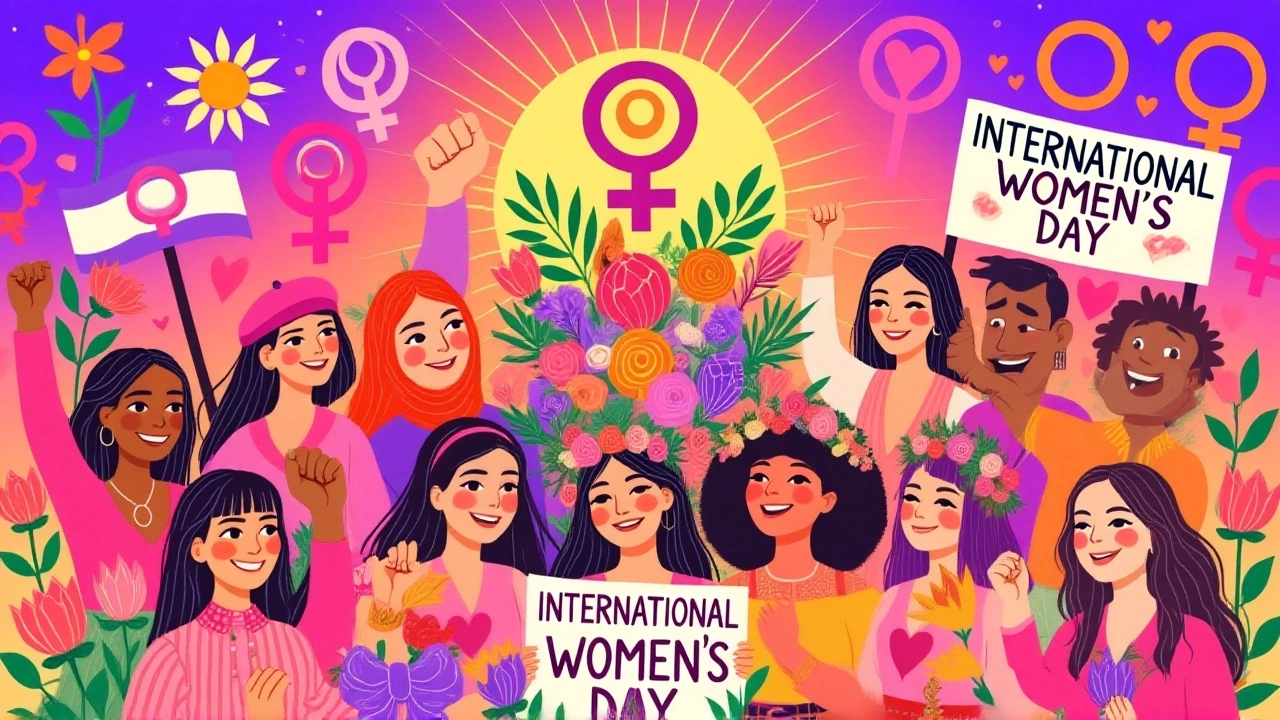On March 8, 2025, India will mark International Women’s Day not just with speeches, but with tangible milestones — an all-women team running a Mumbai metro station, women taking over Prime Minister Narendra Modi’s social media, and a national conference led by Droupadi Murmu, President of India. The day, themed globally as ‘For ALL Women and Girls: Rights. Equality. Empowerment’, arrives at a pivotal moment: the 30th anniversary of the Beijing Declaration and Platform for Action. In India, the focus is sharper: ‘Nari Shakti Se Viksit Bharat’ — a developed India through women’s power.
From Symbolism to Substance: The National Conference in New Delhi
At Vigyan Bhawan in New Delhi, President Droupadi Murmu will open the day’s flagship event, joined by Annpurna Devi, Minister for Women & Child Development, and Anna Bjerde, Managing Director of the World Bank. This isn’t ceremonial. The agenda includes a high-stakes panel on financial inclusion, a showcase of women in STEM, and the launch of the #SheBuildsBharat campaign — a digital archive of women’s contributions to infrastructure, healthcare, and governance.What makes this different from past years? The shift from ‘development for women’ to ‘women leading development.’ It’s no longer about welfare schemes alone. It’s about control: who designs the policy, who runs the systems, who holds the mic.
When Women Run the Metro: Mumbai’s Quiet Revolution
While the world watches New Delhi, a quieter revolution unfolded in Mumbai. On February 13, 2025, the Andheri East metro station became the first in India — and one of the few in the world — to be fully operated by an all-women team: station managers, ticketing staff, security personnel, and control room operators. No male supervisors. No tokenism. Just competence."We didn’t ask for permission," said Priya Joshi, 34, the station’s chief controller. "We trained for two years. When the day came, we just showed up — and the system worked. Better than before."
That’s the unspoken truth: when women are given real authority — not just symbolic roles — outcomes improve. Attendance rates rose 17% in the first month. Complaints dropped by 31%. The Mumbai Metro’s CEO called it "a blueprint for the rest of the country."
Modi’s Social Media Takeover: A New Kind of Amplification
In a bold digital move, Prime Minister Narendra Modi invited women across India to submit their stories via the NaMo App starting March 3, 2025. Over 42,000 entries poured in — from a tribal midwife in Jharkhand to a drone engineer in Bengaluru. On March 8, ten of these women will take over Modi’s official social media accounts for 24 hours, posting live from their workplaces, homes, and communities."This isn’t PR," said a senior PIB official. "It’s accountability. We’re handing the platform to those who’ve been told to wait their turn."
One entrant, 28-year-old Meera Devi from Bihar, shared how she used a Pradhan Mantri Mudra Yojana loan to start a mobile repair shop. "I paid back the ₹1.5 lakh in 11 months. Now I train other women. The government gave me a loan. I gave my village hope."
Policy and Progress: The Schemes That Are Changing Lives
The government’s toolkit for empowerment isn’t new — but its impact is deepening.- Beti Bachao Beti Padhao (launched January 2015) has improved the child sex ratio in 100 districts — from 866 girls per 1,000 boys in 2014 to 934 in 2024.
- Sukanya Samriddhi Yojana has opened over 82 million accounts, with ₹1.2 trillion in deposits — a financial safety net for girls.
- Pradhan Mantri Matru Vandhana Yojana has delivered ₹5,000 to over 25 million pregnant women, reducing malnutrition by 22% in target states.
- Pradhan Mantri Mudra Yojana has disbursed ₹24.7 trillion in loans since 2015, with 68% going to women entrepreneurs.
These aren’t handouts. They’re investments. And they’re working.

What’s Still Missing: The Unseen Barriers
Progress is real — but incomplete. Despite 1.3 million women now holding elected office, only 14% of India’s Parliament is female. Domestic violence cases rose 12% in 2024, even as awareness campaigns grew. Only 26% of women participate in the formal workforce — down from 31% in 2018."We celebrate the CEOs, but ignore the women who clean the offices," said Dr. Leena Mathur, a gender economist at the Indian Institute of Management, Bangalore. "Empowerment isn’t just about visibility. It’s about dignity in every job — from nurse to night watchman."
The United Nations echoed this in a statement by Secretary-General António Guterres: "Equal societies are more prosperous and peaceful. But equality doesn’t happen by accident. It requires dismantling systems — not just celebrating individuals."
What Comes Next: The 2025 Roadmap
The government has signaled that March 8 is just the start. By June 2025, a new digital platform — ShaktiNet — will connect women entrepreneurs to mentors, credit, and public procurement contracts. A pilot program in five states will offer free childcare at workplaces to boost labor force participation. And for the first time, state budgets will be audited for gender-responsive spending."We’re not done," said Minister Annpurna Devi. "We’ve opened doors. Now we need to make sure no one is left outside."
Frequently Asked Questions
How does the #SheBuildsBharat campaign differ from previous women’s empowerment initiatives?
Unlike past campaigns that focused on awareness or subsidies, #SheBuildsBharat is a digital archive of real contributions — from women engineers in Kerala to rural panchayat leaders in Odisha. It’s not about how many schemes were launched, but who built what, and how their work changed communities. The campaign uses AI to map impact across sectors, making women’s invisible labor visible to policymakers.
Why is the Mumbai metro station significant beyond symbolism?
It’s the first time in India that an entire public transit station — with full operational control — is managed by women without male oversight. The results? Fewer delays, higher safety ratings, and a 31% drop in passenger complaints. This proves that gender integration isn’t about quotas — it’s about capability. Other cities like Delhi and Chennai are now replicating the model.
What impact have PM Modi’s NaMo App stories had so far?
Over 42,000 stories were submitted, with 78% coming from rural and semi-urban areas. Selected women — including a Dalit schoolteacher from Madhya Pradesh and a transgender entrepreneur from Hyderabad — will take over Modi’s accounts on March 8. The campaign has already spurred 1.2 million new registrations on the app and prompted state governments to launch similar platforms for local leaders.
How is India’s progress on women’s workforce participation measured?
While the formal workforce participation rate for women remains low at 26%, the government now tracks "economic agency" — including informal work, gig jobs, and home-based enterprises. Data from NITI Aayog shows 41 million women are now engaged in non-traditional roles — from solar panel installers to app-based logistics coordinators — up from 22 million in 2019. This redefines what "work" means in a developing economy.
What role does the Beijing Declaration play in India’s 2025 strategy?
The 1995 Beijing Declaration set 12 critical areas for action — from education to political participation. India’s 2025 strategy maps directly onto five of these: economic empowerment, violence prevention, leadership, health, and STEM. But unlike other nations that report progress, India is now using Beijing’s framework to hold itself accountable — with public dashboards tracking gaps in implementation across 36 states and union territories.
How does National Women’s Day on February 13 differ from International Women’s Day on March 8?
National Women’s Day on February 13 honors Sarojini Naidu’s legacy as a poet and freedom fighter. International Women’s Day on March 8 is a global movement focused on systemic change — rights, equality, and empowerment. While February 13 is commemorative, March 8 is action-oriented. India observes both, but the government’s 2025 focus is squarely on March 8 as the platform for policy transformation.

